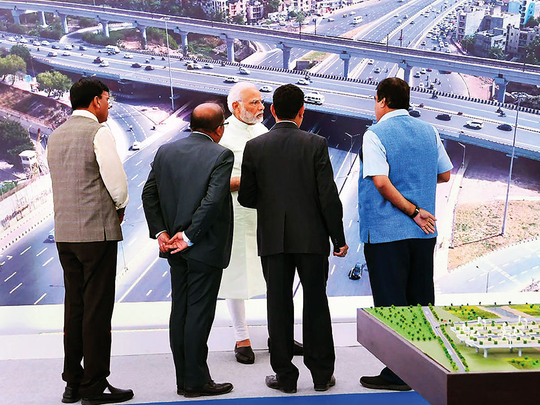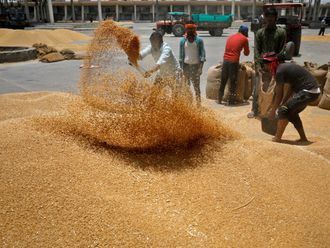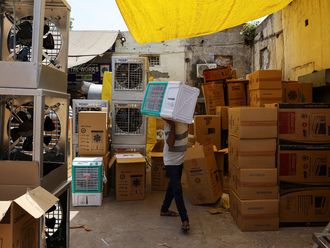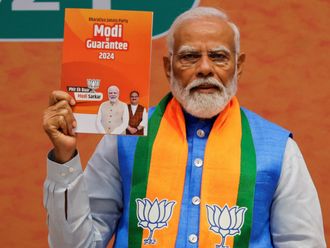
Baghpat (UP): Indian Prime Minister Narendra Modi on Sunday inaugurated the first phase of the Rs75 billion (Dh4.07 billion) expressway that will considerably reduce travel time between national capital Delhi and Meerut in adjoining Uttar Pradesh state.
Modi, after inaugurating the 14-lane Delhi-Meerut Expressway spanning Sarai Kale Khan in Delhi to UP Gate, rode in an open car, waving at crowds gathered on either sides of the highway.
Road Transport and Shipping Minister Nitin Gadkari too rode in a separate open car alongside Modi.
The roadshow started from Nizamuddin bridge, the start of the about 9-km first leg of the Delhi-Meerut Expressway.
After a 6-km travel on the stretch, he flew to Baghpat in Uttar Pradesh to inaugurate the country’s first smart and green highway, the Eastern Peripheral Expressway.
The first phase of the Delhi-Meerut Expressway costed Rs8.42 billion on building the 9-km stretch of 14-lane highway, according to an advertisement released by the government on the project.
The expressway, which will have dedicated bicycle tracks on the nearly 28-km stretch between Delhi and Dasna, will cut travel time between Delhi and Meerut to 45 minutes from two-and-half hour now. The total length of the project is 82km, of which the first 27.74km will be 14-laned, while the rest will be 6-lane expressway.
The expressway will do away with 31 traffic signals on the Delhi-Meerut road, the busiest highway in the region, and make it signal free.
Modi had in December 2015 laid the foundation stone of the Delhi-Meerut Expressway to be built at a cost of Rs75.66 billion.
The project is being built in four segments — Nizamuddin Bridge to UP Border, UP Border to Dasna, Dasna to Hapur and Hapur to Meerut.
Besides, six-laning of 22km long Dasna-Hapur section of NH 24 will cost Rs11.22 billion.
Asserting that infrastructure is a key priority of his government, Modi said Rs3 trillion has been spent on laying a network of 28,000km of highways.
Highways, railways, airways and I-ways have been the focus of the government, he said.
Highways construction has reached 27-km a day now from mere 12-km a day during the Congress regime, while last year 100 million people undertook air travel, he said.
Modi was addressing a public rally in here after dedicating the Eastern Peripheral Expressway (EPE) to the nation. The 135km EPE has been built at a cost of Rs110 billion in 500 days.
He said that apart from Rs5 trillion provision for Bharatmala for highways, a provision of Rs14 trillion was made in the budget to strengthen agriculture related infrastructure.
The government is sensitive to the plight of sugarcane farmers and adequate steps are taken to provide proper prices for their crop, he said.
While talking about social justice, Modi said his government is committed to the protection of dalits and has constituted special courts for fast-track hearing of cases of atrocities.
Lauding Uttar Pradesh Chief Minister Yogi Adityanath, he said criminals in UP are now surrendering themselves and pledging not to indulge in illegal acts.
About the Ganga cleaning programme, Modi said more than 200 projects worth Rs210 billion for have been taken up.
Taking a jibe at Congress, Modi said it had betrayed people for 70 years and played politics to create a crisis of confidence whether related to EVMs or other critical issues.
He said the opposition was spreading rumours on farmer issues and asked people not to give credence to lies about farms being given on contract farming.
In his about 50 minute-speech, he said all-round development work has been initiated.
Transport and Highways Minister Nitin Gadkari said, the expressway will reduce 27 per cent pollution and ease 41 per cent traffic jam.
He said the highway was built in a record 500 days against 910 days time.
Gadkari said the Delhi-Meerut expressway will be completed by next March and reduce the travel time between the two cities to 40 minutes from two-and-half hours at present.
A lot of traffic, outbound or non-destined for Delhi will be diverted, he has said, adding that at least 50,000 vehicles going to Jammu & Kashmir, Punjab, Haryana, Uttrakhand, Uttar Pradesh and Rajasthan will be diverted bringing down pollution.
The alignment of EPE starts near Kundli and passes through six Parliamentary Constituencies — Sonepat, Bagpat, Gaziabad, Noida, Faridabad and Palwal.
Gadkari also announced that Delhi-Saharanpur Highway will be built on EPE pattern and foundation stone of the Rs70 billion Dwarka Expressway will be launched soon by the Prime Minister.
Besides, he announced the Rs450 billion Delhi-Mumbai project via Jaipur and Vadodara on a new alignment, which will save Rs160 billion on land acquisition.
Highlights of the project
■ EPE is India’s first highway to be lit by solar power besides provisions of rain water harvesting every 500 metre on both sides. It also showcases 36 national monuments and 40 fountains.
■ There are 8 solar power plants on this expressway having a capacity of 4000-kilo watt (4MW).
■ The state-of-the-art road has a radar system to catch speeding motorists. It will have provisions of toll only for the distance travelled. The expressway has an iconic toll plaza at the entry point on Kundli side besides digital art gallery.
■ It is also equipped with smart and intelligent highway traffic management system (HTMS) and video incident detection system (VIDS) and is environment-friendly with world-class safety features and smart/ interactive infrastructure.
■ The foundation stone of the greenfield project was laid by Modi on November 5, 2015.
■ About 250,000 trees have been planted alongside the expressways including transplant of 8-10 year old trees with drip irrigation system for plantation.
■ It has consumed 1.1 million tonnes of cement, 100,000 tonne of steel, 36 million cubic metres earthwork and 12 cubic metres fly-ash. Gadkari has said earlier that the project has generated employment opportunities of about 5 million man-days and 9,375 manpower was deployed here.
■ The fully access-controlled six-lane expressway provides entry and exit designated interchanges only. It has 406 structures of which 4 are major bridges, 46 minor bridges, 3 flyovers, 7 interchanges, 221 underpasses and 8 ROBs.
■ The project had earlier faced resistance from farmers over land and other issues which have since been solved by giving higher compensation.
■ The Supreme Court on May 10 had directed the NHAI to throw open the Eastern Peripheral Expressway for the public by May 31, asking why were they “waiting” for its inauguration by the Prime Minister.
■ The apex court had said if the 135-km expressway is not inaugurated on or before May 31, it should be thrown open for public who were facing traffic congestion in Delhi.
■ The Eastern and the Western Peripheral Expressways were planned in 2006 following the apex court’s order to build a ring road outside the national capital for channelling the traffic not bound for Delhi.
— PTI












